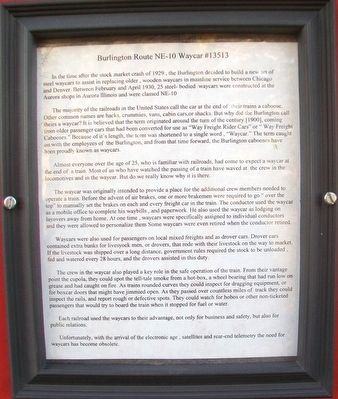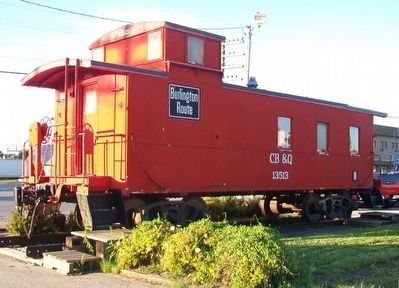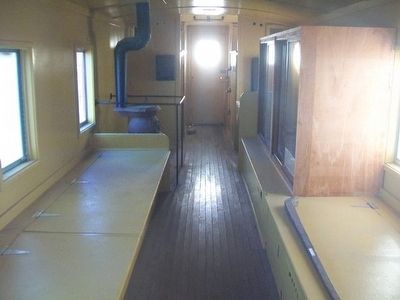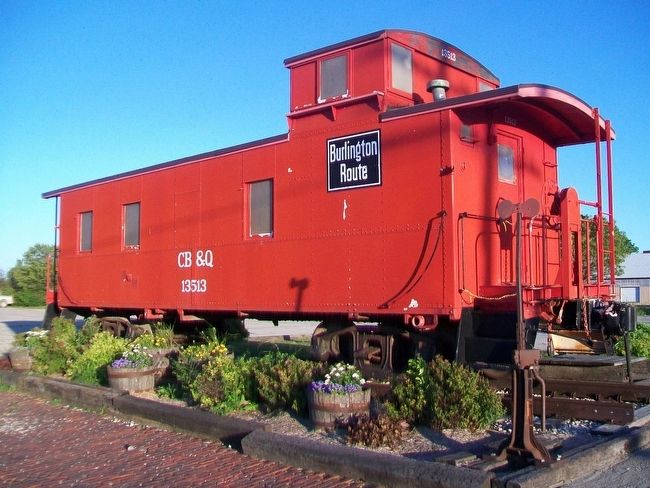Burlington Route NE-10 Waycar #13513
In the time after the stock market crash of 1929, the Burlington decided to build a new set of steel waycars to assist in replacing older, wooden waycars in mainline service between Chicago and Denver. Between February and April 1930, 25 steel-bodied waycars were constructed at the Aurora shops in Aurora Illinois and were classed NE-10.
The majority of the railroads in the United States call the car at the end of their trains a caboose. Other common names are hacks, crummies, vans, cabin cars, or shacks. But why did the Burlington call theirs a waycar? It is believed that the term originated around the turn of the century [1900], coming from older passenger cars that had been converted for use as "Way Freight Rider Cars" or "Way Freight Cabooses." Because of it's length, the term was shortened to a single word, "Waycar." The term caught on with the employees of the Burlington, and from that time forward, the Burlington cabooses have been proudly known as waycars.
Almost everyone over the age of 25, who is familiar with railroads, had come to expect a waycar at the end of a train. Most of us who have watched the passing of a train have waved at the crew in the locomotives and in the waycar. But do we really know why it is there.
The waycar was originally intended to provide a place for the additional crew members needed
to operate a train. Before the advent of air brakes, one or more brakemen were required to go "over the top" to manually set the brakes on each and every freight car in the train. The conductor used the waycar as a mobile office to complete his waybills, and paperwork. He also used the waycar as lodging on layovers away from home. At one time, waycars were specifically assigned to individual conductors and they were allowed to personalize them. Some waycars were even retired when the conductor retired.Waycars were also used for passengers on local mixed freights and as drover cars. Drover cars contained extra bunks for livestock [sic] men, or drovers, that rode with their livestock on the way to market. If the livestock was shipped over a long distance, government rules required the stock to be unloaded, fed and watered every 28 hours, and the drovers assisted in this duty.
The crew in the waycar also played a key role in the safe operation of the train. From their vantage point [in] the cupola, they could spot the tell-tale smoke from a hot-box, a wheel bearing that had run low on grease and had caught on fire. As trains rounded curves they could inspect for dragging equipment, or for boxcar doors that might have jimmied open. As they passed over countless miles of track they could inspect the rails, and report rough or defective spots. They could watch for hobos or other
Each railroad used the waycars to their advantage, not only for business and safety, but also for public relations.
Unfortunately, with the arrival of the electronic age, satellites and rear-end telemetry the need for waycars has become obsolete.
Topics. This historical marker is listed in this topic list: Railroads & Streetcars. A significant historical month for this entry is April 1930.
Location. 41° 3.425′ N, 94° 21.904′ W. Marker is in Creston, Iowa, in Union County. Marker is at the intersection of Adams Street and Oak Street, on the left when traveling west on Adams Street. Touch for map. Marker is in this post office area: Creston IA 50801, United States of America. Touch for directions.
Other nearby markers. At least 8 other markers are within one mile of this marker, measured as the crow flies. Chicago, Burlington, and Quincy Railroad Depot (about 600 feet away, measured in a direct line); Veterans Memorial (about 700 feet away); Vietnam Veterans Memorial (approx. 0.8 miles away); Civil War Memorial (approx. 0.9 miles away); Barn (approx. one mile away); Lincoln No. 5 School (approx. one mile away); Depot, Caboose and Signal tower (approx. one mile away); Log Cabin (approx. one mile away). Touch for a list and map of all markers in Creston.
Also see . . .
1. Burlington Route Historical Society
2. The Burlington Waycars. (Submitted on August 8, 2015, by William Fischer, Jr. of Scranton, Pennsylvania.)
Credits. This page was last revised on August 31, 2020. It was originally submitted on August 8, 2015, by William Fischer, Jr. of Scranton, Pennsylvania. This page has been viewed 331 times since then and 10 times this year. Photos: 1, 2, 3, 4. submitted on August 8, 2015, by William Fischer, Jr. of Scranton, Pennsylvania.



